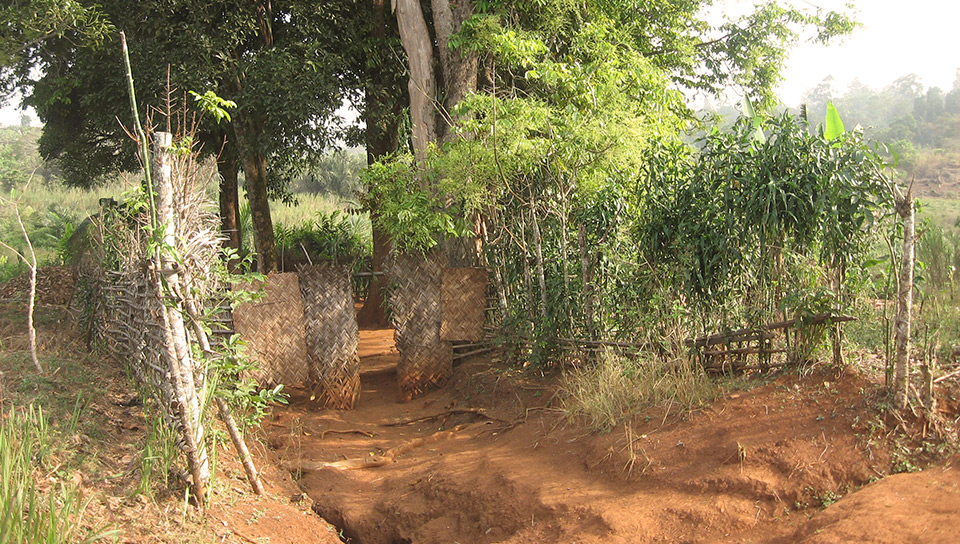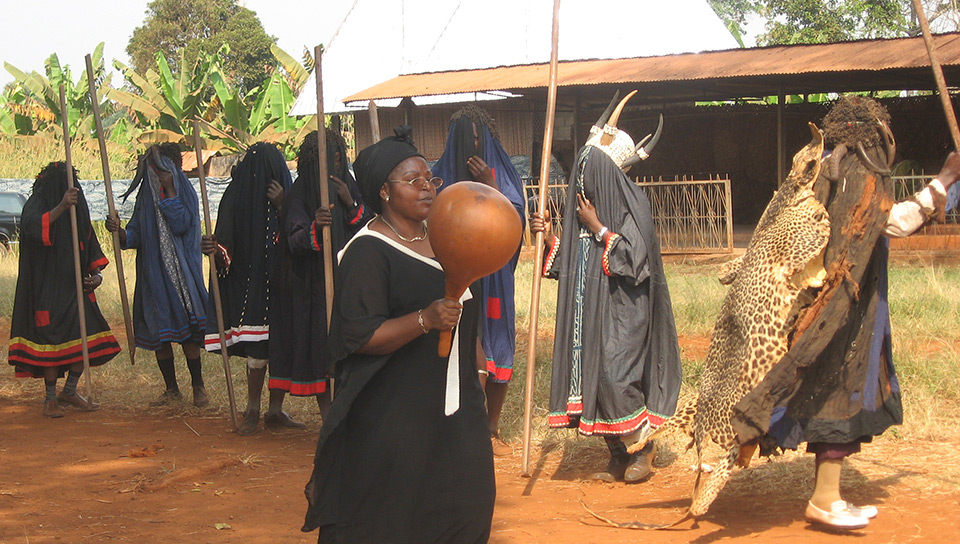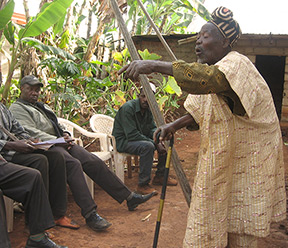I gcríoch Bandjoun in Iarthar na Camarún bréag suímh éagsúla fheictear mar naofa ag na daoine áitiúla. They are the remnant cores of sites that were historically a lot more extensive representing the identity of tribes and communities in the region. The character of separate sites differs in terms of function and the social group that makes use of it. Two examples are family shrines, usually with presence of a fig tree (Ficus sp.), and community gathering places which constitute centres of traditional initiations to the community life. Is é an fheidhm atá roinnte de na suímh is adhartha de na déithe. Cé go bhfuil an éiceolaíocht de na láithreáin nádúrtha naofa beag aird a fuarthas go dtí seo, siad ar eolas a ainmhithe agus plandaí atá imithe den chuid is mó ó na ceantair máguaird cuan.
Bagairtí
Traditional leaders stated that the survival of sacred areas is not threatened because these areas are strongly linked with the community identity. Nevertheless they worry about the changing attitude of young people who are becoming increasingly materialistic and disobey taboos and show lest respect for ancestral beliefs. Sa lá atá inniu, go leor daoine úsáid a bhaint as ceantair naofa gan eolas a chaomhnóir, léiríonn an creimeadh na noirm chultúrtha. Bagairtí Níos mó eochair a aithint, fós an chuid is mó atá faoi díospóireacht i measc na daoine áitiúla iad féin.
Infrastructure development, especially road construction and urban settlement, has caused the degradation of sacred areas in Bandjoun. The expansion of Christianity offers alternative views on the need for protection and honesty. Some Christian priests are said to have a diabolic view on the sacred sites. According to some local traditional spiritual leaders the fact that for Christian’s punishment of wrong deeds comes after death, while for local beliefs punishment takes immediate effect increases people’s disobedience of the ancestral beliefs and taboos.
Mar sin féin, a decreasing influence of Christianity on local beliefs is also reported as well as an increasing willingness of Christian priests to listen to locals and work on an interfaith understanding. According to some, even modern education can have a negative impact on traditional beliefs, due to the decreasing time children spend with their parents. Ina theannta sin, the changing lifestyles cause a decreased interest in traditional values putting the continued care for these sacred natural sites at risk.
Choimeádaithe
Thar na céadta bliain, na daoine Bandjoun a bheith forbartha córas bainistíochta ancestral de láithreáin nádúrtha naofa. Tá an suíomh na láithreacha naofa nádúrtha agus leath-nádúrtha sainaitheanta ag na ceannairí spioradálta tús (MkamSi, Guèkè). Cé go bhfuil an chuid is mó le fada-bhunaithe, the location of a sacred area is not immutable and can be changed for reasons like road construction or socio-political reorientation. Go ginearálta, Tagann gach ceantar naofa faoi fhreagracht coimeádaí a dtugtar Nongtchuép. Tá sé freagrach as tairiscintí agus íobairtí a dhéanamh, ar féidir leis a sainordú freisin ionadaí. These are initiated elders who are universal custodians. Tá an ceart a bheith ag obair i ngach láithreáin adhradh siad.
Even though women are generally regarded as heaving little to do with sacred areas, deeper investigation revealed that their role is present, but hidden and ignored. Mar shampla, Megnesi (female equivalent of MkamSi) have the same capacities and duties as their male counterparts. Only the mothers of initiated twins can clean certain sacred sites. A woman can substitute the family chief and make offerings and sacrifices at a sacred place. Ina theannta sin, the traditional education is primarily given by women who enforce conservation regulations for sacred areas.
Uirlisí Caomhnaithe
Na huirlisí seo a leanas maidir le caomhnú curtha ar bun go dtí seo:
- Tá liosta de bhearta a ghlacadh chugainn
- Tá liosta de na páirtithe leasmhara
- Ráitis na ceannairí traidisiúnta
- Staidéir shóisialta ina bhfuil na daoine áitiúla fís ar an staid
- Léarscáileanna Rannpháirtíochta de na suímh naofa nádúrtha sa réigiún
Fís
Ba mhaith leis an dul chun cinn is mó ag tacú le caomhnú na gceantar naofa a n-aitheantas dlíthiúil, feasacht poiblí méadaithe, athruithe diúltacha a laghdú ar úsáid talún agus aitheantas níos fearr a dtábhacht soch-chultúrtha agus éiceolaíochta. A bhaint amach gach ceann de na thuas beidh gá le rannpháirtíocht na bpáirtithe leasmhara ag leibhéal áitiúil, leibhéil náisiúnta agus idirnáisiúnta.
Comhghuaillíocht
Effective and appropriate support is needed for further conservation of these sites. As a possible solution, Bandjoun community members suggest that involving stakeholders like women, young people, Eagraíochtaí neamhrialtasacha, religious institutions and maybe even state institutions to develop management in sacred areas in a participatory way whilst clearly agreeing on the role of each stakeholder.
Gníomh
Gníomh Little faoi láthair, ach amháin ar feadh cúpla staidéir a ardú feasacht na ndaoine Bandjoun go bhfuilid a láithreacha naofa i gceist. An Banjoun gá acu le tacaíocht chun láithreáin i mbaol nádúrtha naofa tábhachtach do na pobail. Ba mhaith leo a dhéanamh teorannú soiléir acu agus chun straitéis chuí le haghaidh a n bainistiú inbhuanaithe a fhorbairt.
Polasaí agus Dlí
Tá an suíomh naofa nádúrtha sa réimse seo nach n-aithnítear faoi láthair go dleathach. Tá bainistíocht foraoise iomlán an imní na hAireachta Foraoisí agus Fiadhúlra de réir dealbha Cameroonian dlíthiúil.
Mar thoradh ar staidéar sóisialta, Tá feasacht mhéadaithe de na daoine Bandjoun a bhaint amach is tábhachtaí go dtí seo. Is é dearcadh forleathan go bhféadfaí rannpháirtíocht an stáit i mbainistiú na suíomh nádúrtha naofa rioscaí i láthair agus a coimhlint a ghiniúint. Oifigigh Rialtais amhras a iarraidh a hacmhainní cuí, ar intinn acu lagú an cumhacht ag an elders. Tugann baill an phobail a ardú ar fheasacht an phobail, mapáil agus demarcating na teorainneacha na limistéar naofa, eolas a fheabhsú, stakeholders working together and devolving power of the government could all be good solutions to stop the worsening situation.
- Kamga-Kamdem S L., (2010) Ancestral Beliefs and Conservation. The case of sacred natural sites in Banjoun, west Cameroon, i Verschuuren, B., Wild R., McNeeley, J. agus Oviedo., G. (Eds.) Láithreáin Nádúrtha Naofa, Cineál Caomhnú agus Cultúr, Earth Scan, Londain,.pp. 119-128.






